Today the focus is on Bulbasaur and its evolutions Ivysaur and Venusaur. There's quite a bit going on with this grass-type Pokemon as far as visual rhetoric goes, which makes it a prime choice to start this blog with. For those that have not worn their thumbs raw on Gameboy colors, had pages of their Pokemon manga slowly decayed from constant turning, or lost vision from watching multiple episodes of the anime, then here is a visual representation of Bulbasaur and its evolutions:
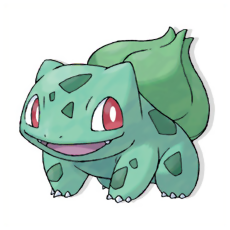
This image is the newest piece of artwork of Bulbasaur, or フシギダネ (Fushigidane) in Japanese, done by artist Ken Sugimori for the games Pokemon FireRed and LeafGreen.
While I could go into heavy detail about the game statistics of Bulbasaur, that is not my goal with this blog. However, the first link on my Works Cited below details about anything you would need to know on Bulbasaur's attacks and statistics in the game. However, a few things about the Game and Bulbasaur need to be noted:
1. Bulbasaur converted from simply Grass type in the original Game Boy games of Green, Red, and Blue to a Grass/Poison type later on. The complexities of this change could come with the type of new attacks it was given.
2. Bulbasaur represents the "balancer" of the starter three, as I will discuss later. This means that it evolves at an equal rate; into Ivysaur at level 16 and into Venusaur at level 32.
3. According to Bulbapedia, the pokemon wiki, Bulbasaurs in the game are primarily male, with your chance at "catching" a female of the species only at 12.5 percent. An interesting notion I will expand upon momentarily.
As far as its name goes, Bulbasaur according to Bulbapedia has this origin in body and name:
Origin
Bulbasaur appears to be based on some form of Dicynodont, mammal-like reptiles from the Permian period, though it also has features from toads and frogs as well as other reptiles. Its also has visible ears, which are not seen in reptiles but are in mammals. Its bulb resembles that of a lily or onion.
Name origin
Bulbasaur's name is a combination of the words bulb and saur, which is Greek for lizard. Its Japanese name literally means "it's strange, isn't it?", and is a pun on, 不思議種 fushigidane, "strange seed".
Other country languages:
Chinese (Taiwan and mainland China): 妙蛙種子/妙蛙种子 Miào Wā Zhǒng Zǐ - "Weird frog seed".
Chinese (Hong Kong): 奇異種子 Qí Yì Zhǒng Zǐ - "Unusual seed".
French: Bulbizarre - A combination of bulb and bizarre, reflected by the Japanese name, a pun on "Isn't it strange?".
German: Bisasam - Derived from Bisamratte (muskrat) and Samen (seed).
Korean: 이상해씨 Isanghaessi - Translates to Strange Seed.
Portuguese (Brazilian, anime only): Bulbassauro - Adaptation of Bulbasaur.
Russian: Бульбазавр - Adaptation of Bulbasaur.
Serbian (anime only): Булбасаурус - Adaptation of Bulbasaur. Caypyc means "dinosaur" in Serbian.
While I do not wish to expand on its name beyond what I've posted, I do hope to visually develop an understanding of its design.
Bulbasaur does indeed carry a strange bulb on its back that for attacks and growth absorbs sunlight. As you find with its later evolutions, the sunlight absorbed is used in attacks such as Solar Beam, highly effective amongst its arsenal. As Bulbasaur evolves, the bulb grows, causing it to start to bloom when it transforms at level 16 into Ivysaur (フシギソウ Fushigisou):

Note the leaves become more tropical and fern-like in design, a throwback to the stereotypical "dinosaur" environment on which its based(the Bulbapedia states " Its bulb has now become a bud that resembles the Rafflesia").Additionally, it foreshadows what Venusaur will look like.
Interesting facts about Ivysaur before showing the final evolution and then returning to Bulbasaur are as follows:
1. Its Red and Blue Pokédex entry states that it loses the ability to walk on its hind legs as its bulb gets bigger. Despite this, Ivysaur is always depicted as walking on its hind legs in said games.
2. Ivysaur is the only second stage Grass/Poison Pokémon that does not require an evolution stone to reach its final form.
3. Ivysaur is the only second stage form of the Kanto starters to not be directly seen under the ownership of a main character in the anime. May owns a Venusaur that she evolved from a Bulbasaur but it was never seen onscreen as an Ivysaur.

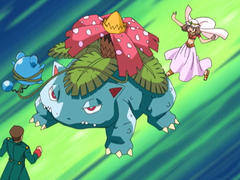
4.Ivysaur is currently the only second stage Grass type starter that's dual-typed.
5.Ivysaur is the only Generation I Pokémon that's name begins with I.
Several jokes are made within the Pokemon community about Ivysaur, specifically tying the visual idea of its vine as a whip, as seen below with a Grass-type using gym leader:
Clearly, being used in sexual connotation is not on Ivysaur's agenda.
The final evolution of Bulbasaur is Venusaur (フシギバナ Fushigibana):

There are a few interesting notations about Venusaur I want to present before looking at Bulbasaur and its evolutions as a whole:
1. Venusaur is the first Pokémon by National Dex order to feature a gender difference. It is the only Kanto starter Pokémon to feature one, if one is not to count Pikachu. The name itself is a reference to Venus as well, not only the second planet from the son, which people parody as seen below, but also the name given to the goddess of love in Greek/Roman constructs (because Aphroditesaur just didn't fit...):

A male Venusaur. Notice the crown in the center of the flower is empty.

Notice with the female there is a seed at the top of the flower, symobolizing fertilization perhaps?
Humorous:

2. Venusaur is probably based on a toad, given that its unevolved forms resemble frogs, but Venusaur displays warts instead of a smooth skin. The plant on its back vaguely resembles the giant flower Rafflesia. It also resembles the mammal-like reptile from the Triassic Period, Kannemeyeria in shape and size.
So returning to Bulbasaur (and its evolutions as a whole) what visual rhetoric can we grasp about this Pokemon other than what I've stated?
I offer that first, Bulbasaur was chosen as the first Pokemon in the Pokedex for several reasons. One could be because of its color. When Pokemon developers were first creating the game, they designed a Pokemon Red and Green version, the Green version game container seen below:

Why was this not released in the US? There are several reasons. One pertained to the game's graphics, which became more developed when Japan re-vamped the games and released a newly revised Pokemon Red and Pokemon Blue. In this process of exportation to the United States and abroad, Pokemon Green was abandoned, and labeled a "test experiment" due to graphic and game glitch problematics.
Visual rhetoricians who examine the use of color will note that Green constantly represents Progression, Experimentation, life, Vitality; all terms that could be used in the development of Pokemon Green. Connected to Green is also the connotation of nature, which definitely presents itself when examining how Bulbasaur evolves.
Bulbasaur also functions to demonstrate a dual purpose of linear rules in Pokemon game. Gamers, especially children, come to discover that Bulbasaur mimics the photosynthesis process of converting sunlight into energy it can use, and can as a result grow and evolve into its latter forms. In addition, Bulbasaur is the a great representation of how the game works: The more you use your Pokemon, the stronger they get, and thus, they evolve and become stronger. Older gamers have complicated this process by even going to lengths of designing "x-rays" to show their physical makeup in a very "real world" display.

Interestingly enough, Bulbasaur also represents a "balancer" amongst the other Starter Pokemon. Despite being the first in the Pokedex, Bulbasaur is not the logical "first" choice a trainer could make when concerned with the first gym leader. While Bulbasaur is ideally the best starter for handling Misty, the second gym leader who specializes in water types, it is weak as a candidate for the third, Lt. Surge (electric type trainer), but the middle "man" when it comes to the first gym leader Brock who trains Rock types (NOTE: It's fascinating when you think about it, because each type represents a different advantage and disadvantage ratio for the 1st three gym leaders. i.e. Charmander is the worst choice of the three technically; not very effective against Brock, at a huge disadvantage against Misty, and decent against Lt. Surge, while Squirtle is great against Brock, decent against Misty, and a terrible decision for battling Lt. Surge). In the anime, the main character Ash wanted to choose Bulbasaur second, after Squirtle, a possible hint for trainers in the game as far as which route to choose when selecting a starter pokemon. What in my opinion makes Bulbasaur a true "balancer" besides this is the fact that it evolves evenly. While Squirtle and Charmander reach their final evolutions at level 36, Venusaur is evolved at level 32, exactly 16 levels after its first evolution at level 16.
Finally, I want to examine the visual representation of Bulbasaur and its evolutions. While, it appears in the first two stages as gender neutral,

we must question the binary of its actual gender ratio in the game to how it is portrayed outside the games. I want to look at fans' personifications of Bulbasaur and its evolutions, since this is a constantly used artistic tool with fans and non-human entities (that is, to transform them into humanoid figures).
In the game, there is only a 12.5% chance of a female Bulbasaur, Ivysaur, or Venusaur being present, yet, examine these examples of (Venusaur specifically) personifications of this Pokemon:

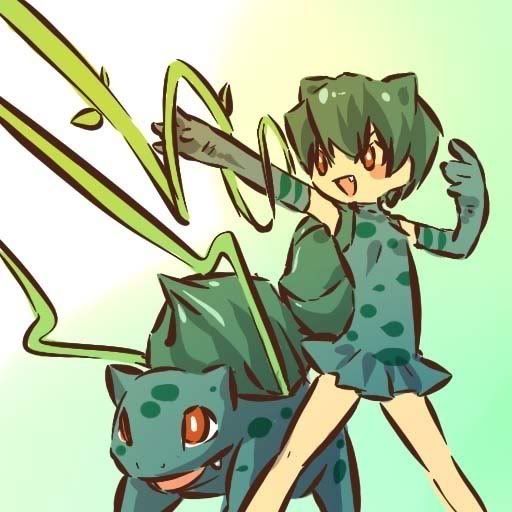
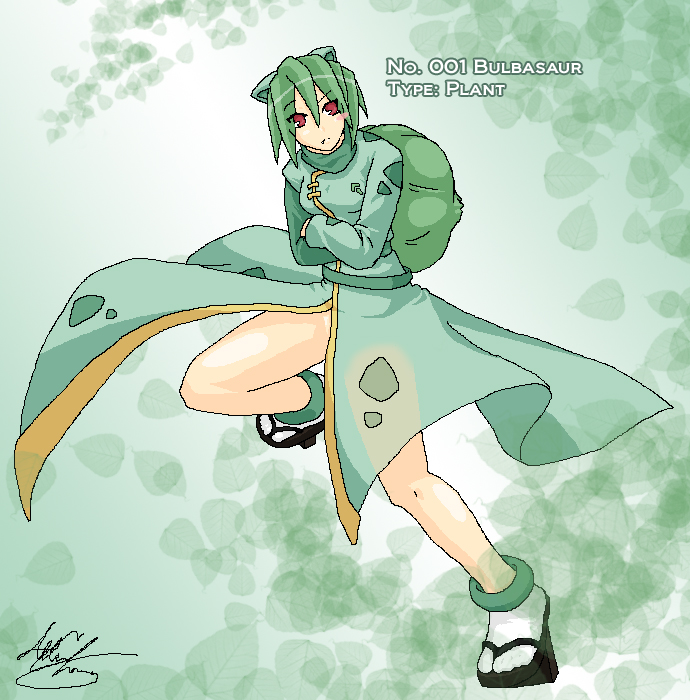
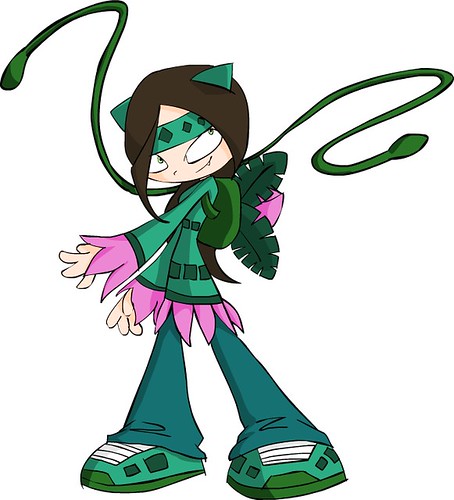







What are the same about all these images? Other than them being the most popular on google search for "Bulbasaur/Ivysaur/Venusaur/Human/Personification," notice something else? They are all feminine representations.
This is something to ponder, as the game itself limits the amount of females in the game available severly, yet we associate Bulbasaur and its evolutions with feminine constructs. One could argue that Venusaur's name and the flower on its back begs for female representation, but juxtaposed with a masculine dinosaur body, our questions of what is "beauty" and if beauty = power are thrown into play. The counter to the Venusaur = female argument is that Bulbasaur does not have feminine features, yet is almost exclusively portrayed as a woman when personified. Look at the second to last image. According to the game, that Venusaur is male, yet it is personified as a woman. And yes, while there are exceptions,

Even when Bulbasaur (or rather Ivysaur here) is given a male personification, there is underlying affemination contributed to that construct. Here, James, a member of the antagonist group Team Rocket, is shown in an Ivysaur costume. Numerous critics and readers alike though, attribute homosexuality to the character of James, feminizing Ivysaur in this case. One could argue though that while the depiction of James as Ivysaur being entranced by a flower could be Demasculinizing, we could also wonder if he's actively participating in a masculine role, seeking a mate in the form of said flower. Here the artist gives us no context clues as to the answer, only leaving us to our interpretations.
I only mention this section because visually, the representation of bulbasaur compared to the gaming statistics doesn't match up. Or, perhaps since the female Bulbasaur is so rare, as is its evolutions, it is overly displayed by fans as feminine.
So, today we examined Bulbasaur, Ivysaur, and Venusaur. I hope I brought some interesting notions visually about this Pokemon. If you have anything to add, please comment and let me know! I hope to have a new installment up as soon as possible. Until then, Get out your Gameboy, catch as many Pokemon as you can, and don't forget to think about the visual rhetoric at play!
-Rushelle
Works Cited:
Website: http://bulbapedia.bulbagarden.net/wiki/Bulbasaur_(Pok%C3%A9mon)
this is really interesting. However, I do have one question: in the artistic renderings where Venusaur is portrayed next to a human counterpart, perhaps it is more a companion situation than a representation. For example the 2nd to last picture, the Venusaur is male and the woman could be a female partner rather than a female depiction of Venusaur.
ReplyDeleteHowever, I do really agree with most everything you've said here. Well done!
That's a really good point Sarah! I hadn't seen where the seed wasn't; great observation! I'm sure that's definitely possible/probable here. I hadn't looked into the companionship aspect, but hopefully in my next post I'll keep that in mind!
ReplyDeleteThanks for the comment,
Rushelle.
I hate to burst your bubble a bit but gijinka art is predominately female portraying. It doesn't matter if the 'mon is traditionally more masculine, gijinka has more female than male personifications. It's not really anything to do with the pokemon itself, but the expectation of what gijinka is.
ReplyDelete